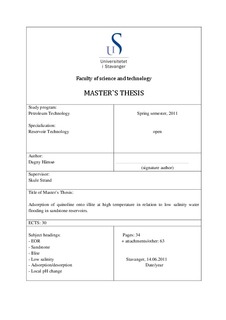| dc.contributor.author | Håmsø, Dagny | |
| dc.date.accessioned | 2011-10-28T11:17:50Z | |
| dc.date.available | 2011-10-28T11:17:50Z | |
| dc.date.issued | 2011 | |
| dc.identifier.uri | http://hdl.handle.net/11250/183349 | |
| dc.description | Master's thesis in Petroleum engineering | no_NO |
| dc.description.abstract | Laboratory tests, as well as field tests, have shown that low salinity water flooding in sandstone reservoirs can improve the water wetness of the rock and thereby increase the oil recovery. Many mechanisms have been suggested in the last decades but none of these mechanisms are completely accepted and research is still going on. Austad et al. (2010) have recently suggested a new chemical mechanism based on a local increase in pH at the clay surface. By injecting low salinity brine a local pH increase at the clay surface will result in desorption of organic material.
Former research on low salinity has mainly been performed on temperatures below 100 °C.
In this connection experimental adsorption/desorption measurements on illite are carried out, both at ambient temperature and at 130 °C. The clay was taken from the Rochester formation in New York in the form of green shale containing about 85 % illite. Quinoline was used as model basic material with a concentration of 0,01 M. Four different brines were used, 1000 mg/l (LS), 25000 mg/l (HS), 25000 mg/l pure CaCl2 and 201 000 mg/l Varg formation brine. The results clearly indicate that adsorption/desorption of basic organic material is strongly pH dependent. When the pH increased, initially adsorbed quinoline was desorbed from the clay surface and the process was reversible. The amount of active cations, especially Ca2+, seems to play a role where adsorption decreases as concentration of Ca2+ increases. Adsorption/desorption measurement performed at 130 °C clearly indicate that the water-wetness of the clay is improved due to lower adsorption. At higher temperature it is believed that the active ions have a stronger affinity towards the clay surface. As the concentration of Ca2+ is increased, the adsorption decreases. | no_NO |
| dc.language.iso | eng | no_NO |
| dc.publisher | University of Stavanger, Norway | no_NO |
| dc.relation.ispartofseries | Masteroppgave/UIS-TN-IPT/2011; | |
| dc.subject | petroleumsteknologi | no_NO |
| dc.subject | reservoarteknologi | no_NO |
| dc.subject | EOR | no_NO |
| dc.subject | sandstone | no_NO |
| dc.subject | illite | no_NO |
| dc.subject | low salinity | no_NO |
| dc.subject | adsorption/desorption | no_NO |
| dc.subject | local pH change | no_NO |
| dc.title | Adsorption of quinoline onto illite at high temperature in relation to low salinity water flooding in sandstone reservoirs | no_NO |
| dc.type | Master thesis | no_NO |
| dc.subject.nsi | VDP::Technology: 500::Rock and petroleum disciplines: 510::Petroleum engineering: 512 | no_NO |
